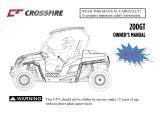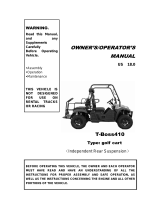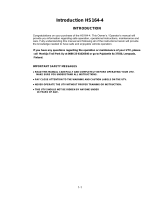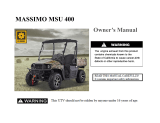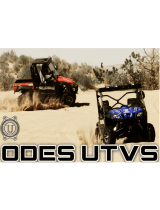Page is loading ...

Minimum Age Requirement 16
Rev.C
021309
OWNER’S MANUAL
BO250 UTV
Read this manual carefully. It contains important safety information.
No one under the age of 16 should operate this UTV
Always wear a helmet; It could save your Life!
Please obtain, review, and follow provincial / municipal government acts and regulations
pertaining to owning and operating an off-road vehicle.

2
Congratulations on your purchase of the
Baja Motorsports UTV
It is warranted to be free of manufacturing defects in the material
of workmanship for a period of 90 days from the date of purchase.
During the warranty period BAJA, INC. will at its option, repair, provide
replacement parts or replace your Baja Motorsports UTV at no charge.
This warranty does not cover normal wear items or damage caused by
neglect or misuse of the product.
Engine Warranty – 90 days
Frame Warranty – 90 days
Warranty is void if:
Frame is bent or broken due to abuse
Wheels are bent or broken
Fender bent or broken due to abuse
Any sign of impact, accident, jumping, spin-outs or roll over.
BAJA, INC. is not liable for any damage claim or liability claim person or
otherwise resulting from the operation of this product in any way.
Should you experience a problem or need to return your Baja Motorsports UTV for repair,
please call the BAJA MOTORSPORTS customer service department TOLL FREE at 1-888-863-
BAJA (2252) between the hours of 7am and 5pm Monday thru Friday PST and Saturday 8am to
4pm PST. During DST hours change to MT. You will be instructed how to proceed.
A COPY OF THE SALES RECEIPT IS REQUIRED.

3
This manual should be considered as a permanent part of the vehicle and
should remain with the vehicle when resold or otherwise transferred to a
new user or operator. The manual contains important safety information and
instructions which should be read carefully before operating the vehicle.
WARNING
!
The engine exhaust from this product contains chemicals known to the State
of California to cause cancer, birth defects or other reproductive harm.
CALIFORNIA PROPOSITION 65
WARNING
!

4
TABLE OF CONTENTS
NOTICE TO USERS....................................................................................... 6
BAJA 250cc UTV........................................................................................... 10
LOCATION OF WARNING LABELS.............................................................. 11
CONTROLS AND INDICATORS.................................................................... 14
KEY SWITCH...................................................................................... 14
HEADLIGHT SWITCH......................................................................... 14
EMERGENCY SHUT OFF SWITCH.................................................... 14
HOUR METER..................................................................................... 14
REVERSE INDICATOR LIGHT............................................................ 14
NEUTRAL INDICATOR LIGHT............................................................ 14
FORWARD INDICATOR LIGHT........................................................... 14
FUEL INDICATOR LIGHT.................................................................... 14
TEMPERATURE INDICATOR LIGHT.................................................. 14
TRANSMISSION GEAR SHIFT LEVER............................................. 15
ACCELERATOR PEDAL.................................................................... 15
BRAKE PEDAL.................................................................................. 15
PARKING BRAKE LEVER................................................................. 15
OPERATION INSTRUCTIONS....................................................................... 16
STARTING THE UTV.......................................................................... 16
STOPPING THE UTV.......................................................................... 16
PARKING THE UTV............................................................................. 16
BED LATCH......................................................................................... 16
LOADING AND UNLOADING CARGO BED...................................... 17
TOWING WITH THE UTV............................................................................... 18
TRANSPORTING THE UTV........................................................................... 18
STORING THE UTV....................................................................................... 18
PREPARATION FOR EXTENDED STORAGE................................... 19
RETURNING STORED UTV TO SERVICE........................................ 20
OPERATING YOUR UTV............................................................................... 21
WHAT YOU SHOULD KNOW BEFORE RIDING.......................................... 21
INSPECTION BEFORE RIDING.................................................................... 22
SAFETY GEAR.............................................................................................. 24
BREAK-IN...................................................................................................... 25
STARTING THE ENGINE.............................................................................. 26
BRAKING...................................................................................................... 30
OPERATION ON HILLS................................................................................ 31
OPERATING OVER OBSTACLES................................................................ 32
OPERATING THROUGH WATER................................................................. 33
OPERATING IN COLD WEATHER............................................................... 34
DRESSING FOR COLD WEATHER RIDING................................................ 35
OPERATING YOUR UTV ON SNOW AND ICE............................................. 36

5
TABLE OF CONTENTS
PERIODIC MAINTENANCE SCHEDULE....................................................... 37
PERIODIC LUBRICATION SCHEDULE............................................. 37
AIR FILTER.................................................................................................... 38
RADIATOR..................................................................................................... 39
ENGINE OIL................................................................................................... 39
ENGINE OIL LEVEL CHECK............................................................. 39
ENGINE OIL CHANGE....................................................................... 41
TRANSMISSION OIL CHANGE......................................................... 41
REAR DIFFERENTIAL OIL CHANGE........................................................... 42
FUELING INSTRUCTIONS............................................................................ 43
BATTERY....................................................................................................... 44
PREPARING THE BATTERY............................................................. 45
HOW TO INITIALLY CHARGE THE BATTERY................................. 46
BATTERY REPLACEMENT............................................................... 47
ADJUSTMENTS............................................................................................ 48
SUSPENSION.................................................................................... 48
SPARK PLUG..................................................................................... 48
TIRES.................................................................................................. 50
VEHICLE CLEANING.................................................................................... 51
CLEANING PROCEDURE................................................................. 51
PREPARATION FOR CLEANING...................................................... 51
TROUBLESHOOTING................................................................................... 52
SERIAL NUMBER LOCATIONS................................................................... 53
SPECIFICATIONS......................................................................................... 54
EMISSION CONTROL SYSTEM WARRANTY.............................................. 55

6
Please read this manual and follow all instructions carefully. To emphasize the special
information, the symbol and the words WARNING or CAUTION have some special meanings.
Pay attention to the messages.
NOTE: Indicating special information which is to make maintenance easier or instructions
clearer.
WARNING and CAUTION are arranged like this:
This user’s manual contains important safety and maintenance information. Read it carefully
before riding. Failing to follow the warnings contained in this manual could result in INJURY or
DEATH.
It is important that this manual remain with the vehicle when you transfer it to another user or
owner.
All information, illustrations, photographs and specications contained in this manual
are based on the latest product information available at the time of publication. Due to
improvements or other changes, there will be some discrepancies in this manual. We reserve
the right to make product changes at any time, without notice and without incurring any
obligation to make the same or similar changes to the vehicle previously built or sold.
WARNING
Indicates a potential hazard that could result in death or injury.
CAUTION
Indicates a potential hazard that could result in vehicle damage.
WARNING-or-CAUTION
The rst part will identify a POTENTIAL HAZARD.
The second part will describe WHAT COULD HAPPEN if you
ignore the WARNING or CAUTION.
The third part will describe HOW TO AVOID THE HAZARD.
NOTICE TO USERS

7
We believe in conservation and protection of the earth’s natural resources. We encourage
every vehicle owner and operator to do the same by obeying posted signs and riding only in
areas designated and approved for off-road recreational use.
NOTICE TO USERS
THIS UTV IS NOT A TOY. IT COULD BE HAZARDOUS TO OPERATE. A UTV is different from
other vehicles including motorcycles and cars. A collision or rollover could occur quickly, even
during routine maneuvers such as turning and driving on hills or over obstacles if you fail to
take proper precautions.
· Read this manual and labels on the UTV carefully and follow the operations procedures as
described.
· Never operate the UTV without proper instructions.
· Always avoid operating an UTV on paved surfaces, including: sidewalks, paths, parking lots,
driveways, streets, roads, and highways. Never operate this or any UTV on a public street,
road or highway where motor vehicles are in operation.
· Never operate an UTV without wearing a DOT approved motorcycle helmet which ts
properly. Operators should also wear eye protection (goggles or face shield), gloves, boots,
long-sleeved shirt or jacket, and long pants.
· Never use alcohol or drugs before or during operation of UTV.
· Driver and passenger should always wear seat belts
WARNING
SEVERE INJURY OR DEATH can result if you do not follow these instructions.
NOTICE TO USERS

8
· Never operate this UTV at excessive speeds. Always operate at a speed that is proper for
the terrain, visibility, operating conditions, and the operator’s skill / experience.
· Never attempt jumps or other stunts.
· Always inspect the UTV each time before use to ensure it is in a safe operating condition.
Always follow the inspection and maintenance procedures and schedules described in this
manual.
· Always as an operator keep both hands on steering wheel. Operator and passenger should
always keep hands, arms, legs and feet inside UTV while in operation.
· Always go slow and be extremely careful when operating on unfamiliar terrain. Always be
alert to the changing terrain conditions when operating the UTV.
· Never operate on excessively rough, slippery or loose terrain until you have learned and
practiced the necessary skills to control the UTV on such terrain.
· Never operate the UTV on hills that are too steep for the UTV or for the operator’s ability.
Practice on smaller hills before attempting larger hills. Never attempt climbing hills greater
than a 15 degree incline.
· Check the terrain carefully before you start up any hill. Never climb hills with excessively
slippery or loose surfaces. Never go over the top of a hill at high speeds.
· Check the terrain carefully before starting to go down any hill. Never go down a hill at an
angle that would cause the vehicle to lean sharply to one side. Go straight down the hill if
possible.
· Always use proper procedures if stalling while climbing a hill. Place UTV in reverse and
back down slowly using brakes as needed. To avoid stalling, maintain a steady speed
when climbing a hill. If you stall or roll backwards, follow the special procedure for braking
described in this manual.
NOTICE TO USERS

9
· Always check for obstacles before operating in a new area. Never attempt to operate over
large obstacles, such as large rocks or fallen trees. Always follow proper procedures when
operating over obstacles as described in this manual.
· Always be careful when skidding or sliding. Learn to safely control skidding or sliding by
practicing at low speeds and on level, smooth terrain. On extremely slippery surfaces, such
as ice, go slow and be very cautious in order to avoid going out of control when skidding or
sliding.
· Never operate a UTV in fast owing water or in water deeper than 4 inches. Remember that
wet brakes can reduce stopping ability. Test your brakes after leaving water. If necessary,
apply them several times to let friction linings dry out.
· Always use the tires with proper size and type tires specied in this manual. Always
maintain proper tire pressure as described in this manual.
· Never modify a UTV through improper installation of accessories.
· Never exceed the stated load capacity for an UTV. Cargo should be distributed properly and
attached securely. Reduce speed and follow instructions in this manual for carrying cargo.
Allow longer distance for braking.
· Be sure to remove any/all cargo before raising the cargo bed or servicing UTV. Maximum
load capacity in cargo bed is 400lbs. (181kg) Overloading the cargo bed will cause damage
and danger. Make sure all persons are clear before lowering cargo bed. Do not drop the
cargo bed, slowly lower. Failure to follow these warnings may result in severe injury or
death.
· The combined weight of the rider and any accessories or cargo must never exceed the
vehicle’s load capacity of 850 lbs. (385kg)
NOTICE TO USERS

10
BAJA 250CC UTV
Right
Left
Gas tank
Steering wheel
Front wheel
Cargo bed
Passenger Handle
Key switch
Accelerator and
Brake pedals
Brush guard
Front bumper
Forward/Reverse
lever
Rear wheel
Headrests
Cargo bed latch
Parking brake
lever
Mirror
Radiator ll
cap
Seat Belts
Rear Shocks
Front
Shocks
Cargo bed

11
LOCATION OF WARNING LABELS
1
2
3
4
5
6
7 Located on left and right
side panels
8
9
5
10

12
LOCATION OF WARNING LABELS
2
1
4
3

13
LOCATION OF WARNING LABELS
8
5
7
6
9
10

14
CONTROLS AND INDICATORS
KEY SWITCH
To start the vehicle turn key switch right (CW) and hold until engine is running
smoothly. The engine should now idle. Turn key switch left (CCW) to turn engine
off. NOTE: Key can only be removed when engine is off.
EMERGENCY SHUT OFF SWITCH
For engine to run, the Emergency shut off switch needs to be placed in the “ON”
position.
HEADLIGHT SWITCH
To turn headlights on press the headlight button. Headlights should be off when
engine is not running to prevent the battery from loosing life.
HOUR METER
The hour meter (located under driver seat) only operates when the engine is
running. It tracks accumulative operating time of the engine so you know when to
perform the periodic maintenance.
REVERSE INDICATOR LIGHT
This light will illuminate when the UTV is in reverse.
NEUTRAL INDICATOR LIGHT
This light will illuminate when the UTV is in neutral.
FORWARD INDICATOR LIGHT
This light will illuminate when the UTV is in Forward.
FUEL INDICATOR LIGHT
This light will illuminate when fuel is low.
TEMPERATURE INDICATOR LIGHT
This light will illuminate when engine is overheating.
Hour meter
Key Switch
Headlight switch
Reverse Indicator
Light
Neutral Indicator Light
Forward Indicator Light
Fuel Indicator Light
Temperature
Indicator Light
Emergency shut
off Switch

15
CONTROLS AND INDICATOR
TRANSMISSION GEAR SHIFT LEVER
The transmission gear shift lever is located between the driver and passenger seat
cushion. To put the transmission in forward, place lever down. To put transmission
in reverse, pull lever back. NOTE: Be sure to depress the brake pedal before shifting
in any position.
ACCELERATOR PEDAL
By depressing this pedal the vehicles speed will increase in either forward or
reverse. When the pedal is released it will return to the original position and the
engine will idle.
BRAKE PEDAL
This pedal will slow or stop the vehicle when depressed
PARKING BRAKE LEVER
The parking brake lever is located between the driver and passenger seats. Use this
lever whenever parking the machine, especially on a slope. Apply the parking brake
by pulling up. Release by pressing button on end of lever and lower completely.
Transmission gear
shift lever
Accelerator Pedal
Brake Pedal
Parking Brake Lever

16
OPERATION INSTRUCTIONS
STARTING THE UTV
1. Read warning and loading labels, be sure to secure load (if any).
2. Study and understand all controls and indicators.
3. Fasten seat belt including passenger (if any).
4. Depress the brake pedal, turn ignition key clockwise and hold.
5. Keeping the brake pedal depressed select the direction of travel placing the
drive select lever in either forward or reverse. Release the parking brake.
6. Release the brake pedal and slowly depress the accelerator pedal.
NOTE: Never shift from forward to reverse or vice versa until the vehicle is
completely stopped.
STOPPING THE UTV
Driving through water may affect the brakes. Check the effectiveness of the brakes after driving
through water by gently depressing the brake pedal. If the vehicle does not slow down continue
to depress the brake pedal until the brakes dry out.
PARKING THE UTV
1. Always engage the parking brake when stopping to ensure the vehicle will not roll.
2. Turn the ignition key switch to the off position and remove key.
3.. Wheel chocks are recommended if parking on an incline.
BED LATCH
To lift the bed pull the latch handle upward and the hydraulic stand will secure the bed.
WARNING
Be sure to keep hands and all body parts away from crush
area. Failure to do so could result in severe injury or death.
Bed latch handle

17
WARNING
Make certain the hydraulic stand is secure when working under the bed.
Failure to do so may result in severe injury or death.
WARNING
Do not lower cargo bed until all persons and objects are clear from cargo bed area.
Gently lower cargo bed, do not drop bed down.
Failure to do so may result in severe injury or death.
To lower the cargo bed lift the prop rod and push rod toward the vehicle to free it from the track.
Gently lower bed, do not drop.
LOADING AND UNLOADING CARGO BED
• Engage parking brake before loading anything.
• Never allow riders in cargo bed.
• When driving uphill, downhill or on uneven terrain reduce the load and speed.
• Never exceed the maximum weight capacity of the vehicle.
• Overloading the vehicle can affect vehicle handling and cause components to
fail resulting in injury or death.
• Reduce speed and sudden stops when in reverse to prevent the vehicle from
flipping backward.
• Do not load tailgate. Tailgate must be in the upright position and secure when
vehicle is in motion.
• Avoid sudden starts, stops and turns to help prevent load from shifting and
possibly causing the vehicle to overturn.
• Make sure cargo is well secured to prevent is from shifting and possibly causing
vehicle overturn.
• The center of gravity should never exceed 15 inches from above the bottom of
the cargo bed.
• Remove cargo from bed before raising vehicle (lift, hoist, jack, etc.).
• Avoid stopping on a hill with cargo in cargo bed. If it is necessary to stop on a
hill avoid sudden starts or rolling backward and sudden stopping.
Maximum payload capacity: 850lbs. (385kg)
Maximum cargo capacity: 400lbs. (181kg)
Maximum trailer tongue weight: 100lbs. (45kg)
OPERATION INSTRUCTIONS

18
TOWING WITH THE UTV
• Never tow a vehicle or trailer on public streets or highways.
• Speed should be reduce when towing.
• Use extreme caution.
• Never allow riders in or on whatever is being towed.
• Total vehicle capacity (load weight, weight of whatever is being towed) should not exceed the
previous weight specied.
• Avoid sudden starts, stops and tight turns.
• Avoid stopping on a hill. If it is necessary to stop on a hill avoid sudden starts or rolling
backward and sudden stopping.
• Be sure to always use the parking brake and chocks (if accessible)
TRANSPORTING THE UTV
• Never allow riders on the vehicle.
• Avoid sudden starts, stops and tight turns.
• Avoid stopping on a hill. If it is necessary to stop on a hill avoid sudden starts or rolling
backward and sudden stopping.
• Reduce speed.
• Tie-down securely and set the parking brake.
• Never transports with any load in the cargo bed.
USE AN APPROVED TRAILER THAT HAS A LOAD RATING OF AT LEAST 2000LBS. PER
VEHICLE BEING TRANSPORTED AND OBSERVE ALL WARNING PRECAUTIONS.
STORING THE UTV
DANGER
Do not drain gasoline when engine is hot or running.
Clean any spilled gasoline before operating the vehicle.
Store gasoline in an approved container only. Store in a well-ventilated area away from
sparks, open ames, heaters etc.
Keep gasoline out of reach of children.
Do not siphon gasoline from vehicle.
OPERATION INSTRUCTIONS

19
WARNING
Remove the key and set the parking brake.
Do not charge a frozen battery or batteries with bulging cases. Discard batteries according
to state and local environmental legal guidelines for battery disposal. Frozen batteries may
explode.
CAUTION
Batteries with low charge will freeze at low temperatures.
PREPARATION FOR EXTENDED STORAGE
1. Make sure there is no load in the cargo bed.
2. Store in a cool, dry place. This will help prevent the battery from loosing charge.
3. Drain all gasoline from fuel tank and seal.
4. Run engine until all fuel in carburetor and fuel lines are gone and the engine stalls.
5. Loosen but do not remove the carburetor drain screw allowing the remaining fuel to drain
into a container, then pour the fuel from container into the vehicle fuel tank.
6. Fill the fuel tank 1 inch from the top of fuel tank and add fuel stabilizer.
7. Disconnect fuel tank line from fuel tank vent nipple.
8. Plug the fuel tank vent line air tight.
9. Disconnect battery cables, making sure to disconnect the negative cable rst.
10. Make sure the battery is clean and free of corrosion. Wash the terminals with baking soda
and water (1 cup baking soda per 1 gallon water). Rinse the solution be sure the solution
does not enter the battery. Make sure the terminals are tight, let them dry and coat with
Battery Terminal Protector Spray.
11. Remove the spark plug and pour 1/2 of SAE 10 weight oil into the engine through the spark
plug hole and manually turn the crankshaft several times and reinstall the spark plug.
12. Adjust tires to the recommended tire pressure.
13. Perform any semi-annual periodic lubrication including the front suspension.
14. Thoroughly clean the vehicle.
15. Do not set the parking brake. To prevent the vehicle from rolling, choke the wheels.
OPERATION INSTRUCTIONS

20
RETURNING STORED UTV TO SERVICE
1. Restore the fueling system to operational standards.
2. Remove plug from fuel tank vent.
3. Connect fuel vent line to fuel tank vent.
4. Connect the battery cables making sure to connect the positive cable rst.
5. Engage the parking brake and crank the engine until fuel has pumped into the
carburetor and fuel lines and the engine starts. Turn the engine off.
NOTE: Engine may smoke for awhile when running it the rst time after storage.
6. Adjust the tires to recommended tire pressure.
OPERATING YOU UTV
WHAT YOU SHOULD KNOW BEFORE RIDING
Before riding, you should read all the following information carefully. If you are properly
prepared, you will have a more enjoyable ride.
Before riding, you should nd a good place to practice the skills. Find a at, open area with
enough space to practice the new skills.
OPERATION INSTRUCTIONS
/

